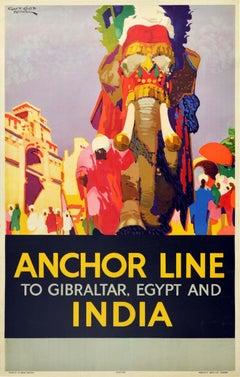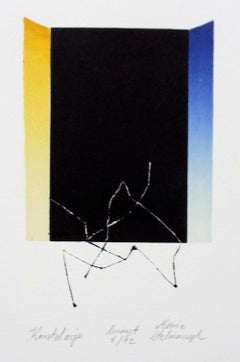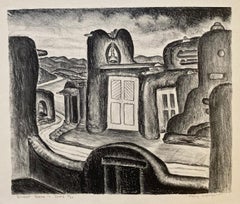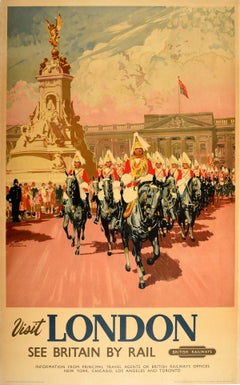Gordon Nicoll Prints and Multiples
to
2
2
2
4
3
1
Overall Height
to
Overall Width
to
1
2
2
1
1
1
1
1
1
1
1
4
1
3
4
986
695
659
625
2
2
Artist: Gordon Nicoll
Original Vintage Travel Poster Visit London See Britain By Rail British Railways
By Gordon Nicoll
Located in London, GB
Original vintage British Railways travel poster - Visit London See Britain by Rail - featuring colourful artwork by Gordon Nicoll (1888-1959) depicting a procession of Horse Guards r...
Category
1950s Gordon Nicoll Prints and Multiples
Materials
Paper
Original Windsor, See Britain by Train vintage poster
By Gordon Nicoll
Located in Spokane, WA
Original Windsor See Britain by Train vintage railroad poster. Linen backed in very fine condition, ready to frame. No restoration to t...
Category
1950s American Realist Gordon Nicoll Prints and Multiples
Materials
Lithograph
Original "Stratford-upon-Avon" vintage British Railways poster
By Gordon Nicoll
Located in Spokane, WA
Original Stratford Upon Avon vintage poster. British Railways,
Artist: Gordon Nicoll Archival linen backed and in fine condition, ready to...
Category
1950s American Modern Gordon Nicoll Prints and Multiples
Materials
Lithograph
Original Vintage Cruise Travel Poster Anchor Line India Elephant Gibraltar Egypt
By Gordon Nicoll
Located in London, GB
Original vintage cruise travel poster advertising Anchor Line to Gibraltar Egypt and India featuring a colourful design by the illustrato...
Category
1920s Gordon Nicoll Prints and Multiples
Materials
Paper
Related Items
Constellation - XXI Century, Contemporary Linocut & Woodcut Print, Abstract
By Maria Stelmaszczyk
Located in Warsaw, PL
MARIA STELMASZCZYK (born in 1983) Studies at the Faculty of Graphic Arts and Painting
Laboratory of Woodcut Techniques and Artistic Book at the Academy of Fine Arts Władysław Strzemi...
Category
Early 2000s Contemporary Gordon Nicoll Prints and Multiples
Materials
Paper, Linocut, Woodcut
Mary Lightfoot, Street Scene in Taos
Located in New York, NY
Mary Lightfoot was born in Ravenna, Texas. She studied at the College of Industrial Arts in Denton and the North Texas State Teachers College prior to receiving a master of arts degree from Columbia University. Her entire teaching career was with the Dallas Public School system; she summered in Europe...
Category
Mid-20th Century American Modern Gordon Nicoll Prints and Multiples
Materials
Lithograph
Nocturn - XXI Century, Mixed Media Landscape Print, Muted Colors, Warm Tones
By Krzysztof Wieczorek
Located in Warsaw, PL
KRZYSZTOF WIECZOREK (1954-2021)
Studied at the Faculty of Graphic Arts at the National School of Fine Arts. He received his diploma from the atelier of prof. Leszek Rózga in 1977.
...
Category
21st Century and Contemporary Gordon Nicoll Prints and Multiples
Materials
Intaglio, Paper, Oil, Acrylic
Prodigal Son
By Thomas Hart Benton
Located in London, GB
A fine impression with full margins published by Associated American Artists with their information label present - pictured in Art and Popular Religion in Evangelical America, 1815-...
Category
1930s American Modern Gordon Nicoll Prints and Multiples
Materials
Lithograph
Philip Cheney, April Thaw
Located in New York, NY
This peaceful, idyllic scene is a perfect example of works published by Associated American Artists in the 1940s -- an American subject, drama-free, and masterfully drawn. It was iss...
Category
Mid-20th Century American Modern Gordon Nicoll Prints and Multiples
Materials
Lithograph
Egea, an edge - XX Century, Abstract Etching Print, Colorful
By Leszek Rózga
Located in Warsaw, PL
Etching on paper, épreuve d'artiste, 1973
LESZEK RÓZGA (1924-2015).
He studied painting at Maria Skarbek-Kruszewska private atelier in 1945-46. In 1948, he began studies at the art...
Category
1990s Abstract Gordon Nicoll Prints and Multiples
Materials
Etching, Paper
Koichi Sakamoto ( 1932 ) Thatched Cottages - Mezzotinto Etching , 11/80 - Japan
By Koichi Sakamoto
Located in Meinisberg, CH
Koichi Sakamoto
(Japanese, 1932)
Thatched Cottages with Mountains beyond
• Mezzotinto etching, sheet ca. 35 x 55 cm
• Plate ca. 20 x 39.5 cm
• Signed bottom right
• Edition 11/80 (...
Category
Mid-20th Century Naturalistic Gordon Nicoll Prints and Multiples
Materials
Pigment, Paper
Free Shipping
H 13.78 in W 21.66 in
Harvest
By Kenneth Miller Adams
Located in San Francisco, CA
This artwork titled "Harvest" c.1930 is an offset lithograph on wove paper by noted Taos, New Mexico artist Kenneth Miller Adams, 1897-1966. It is signed and titled in the plate. Th...
Category
Mid-20th Century American Realist Gordon Nicoll Prints and Multiples
Materials
Lithograph
Ruins of Central City, Vintage 1935 Framed Colorado Modernist Landscape
By Vance Kirkland
Located in Denver, CO
Vintage lithograph titled "Ruins of Central City 31/70" is a modernist landscape with decaying buildings and mountains by Vance Hall Kirkland, from 1935. Presented in a custom black frame with archival materials, outer dimensions measure 25 ⅞ x 29 ⅜ x ⅝ inches. Image sight size is 14 x 17 ¾ inches.
Painting is clean and in very good vintage condition - please contact us for a detailed condition report.
Provenance: Private collection, Denver, Colorado
Expedited and international shipping is available - please contact us for a quote.
About the Artist:
Variously referred to as the "Father of Modern Colorado Painting", "Dean of Colorado Artists", and "Colorado’s pre-eminent artist," Kirkland was an inventive, visionary painter who spent fifty-two years of his fifty-four-year career in Denver. Of the approximately 1,200 paintings he created, about 550 from the first half of his career (1927-1953) are water-based media: acquarelle, gouache, casein and egg tempera, with a few oils. In the latter half of his career (1953-1981) he used oil and his unique oil and water mixture. He also produced five hundred drawings and some ten prints, mostly lithographs on stone, while also engaged in teaching full-time for most of the period.
To show people "something they have never seen before and new ways to look at things," he felt he needed to preserve his artistic freedom. Consequently, he chose to spend his entire professional career in Denver far removed from the established American art centers in the East and Midwest. "By minding my own business and working on my own," he said, "I think it was possible to develop in this part of the country… I’ve developed my kind of work [and] I think my paintings are stronger for having worked that way." The geographical isolation resulting from his choice to stay in Colorado did not impede his creativity, as it did other artists, but in fact contributed to his unique vision.
The son of a dentist, who was disappointed with his [son’s] choice of art as a career, Kirkland flunked freshman watercolor class in 1924 at the Cleveland School of Art (now the Cleveland Institute of Art) for putting colors into his landscapes that did not exist in nature and for competing colors. Not dissuaded, he won first prize for his watercolors in his junior and senior years. [While in Cleveland,] he studied with three influential teachers. Henry Keller, included in the prestigious New York Armory Show in 1913, introduced him to designed realism which he later used in his Colorado landscapes in the 1930s and 1940s. His other teachers were Bill Eastman, who studied with Hans Hofmann and appreciated all the new movements in modern art, and Frank Wilcox, a fine watercolorist.
While a student at the Cleveland School of Art, Kirkland concurrently took liberal arts courses at Western Reserve and the Cleveland School of Education and taught two freshman courses in watercolor and design, receiving his diploma in painting from the school in 1927 by doing four years of work in three. The following year he received a Bachelor of Education in Art degree from the same institution.
In 1929 he assumed the position of founding director of the University of Denver’s School of Art, originally known as the Chappell School of Art. He resigned three years later when the university reneged on its agreement to grant its art courses full recognition toward a Bachelor of Arts degree. His students prevailed on him to continue teaching, resulting in the Kirkland School of Art which he opened in 1932 at 1311 Pearl Street in Denver. The building, where he painted until his death in 1981, formerly was the studio of British-born artist, Henry Read, designer of the City of Denver Seal and one of the original thirteen charter members of the Artists’ Club of Denver, forerunner of the Denver Art Museum. The Kirkland School of Art prospered for the next fourteen years with its courses accredited by the University of Colorado Extension Center in Denver.
The teaching income from his art school and his painting commissions helped him survive the Great Depression. The U.S. Treasury Department’s Section of Fine Arts commissioned from him two post office murals, Cattle Roundup (1938, Eureka, Kansas), and Land Rush (1940, Sayre, Oklahoma). He also did murals for several Denver clients: the Gerald Hughes mansion (1936, later demolished), Arthur Johnson home (1936-37, Seven Drinks of Man), Albany Hotel (1937, later demolished), Neustetter’s Department Store (1937, "History of Costume," three of five saved in 1987 before the building interior was demolished in advance of its condo conversion), and the Denver Country Club (1945, partially destroyed and later painted over).
In 1953 the Ford Times, published by the Ford Motor Company, commissioned Kirkland along with fellow Denver artists, William Sanderson and Richard Sorby, to paint six watercolors each for the publication. Their work appeared in articles [about] Colorado entitled, "Take to the High Road" (of the Colorado Rockies) by Alicita and Warren Hamilton. Kirkland sketched the mountain passes and high roads in the area of Mount Evans, Independence Pass near Aspen, and Trail Ridge Road in Rocky Mountain National Park.
In 1946 Kirkland closed his art school when the University of Denver rehired him as director of its School of Art and chairman of the Division of Arts and Humanities. In 1957 the University gave him its highest honor – the "University Lecturer Award." When he retired in 1969 as Professor of Art Emeritus to become a full-time painter, the School of Arts was the university’s largest undergraduate department. In 1971 Governor John Love presented Kirkland the State of Colorado Arts and Humanities Award. In addition to his dual positions as artist and teacher in Denver for more than half a century, he served the Denver Art Museum as a trustee, chairman of the accessions committee, member of the exhibitions committee, curator of European and American art, and honorary curator of painting and sculpture. He also won the battle with the museum’s old guard to establish a department of modern and contemporary art. Additionally, he was one of the fifty-two founding members of the Denver Artists Guild which included most of Colorado’s leading artists who greatly contributed to the state’s cultural history.
Kirkland developed five major painting periods during his life encompassing various series with some chronological overlap: Designed Realism (1927-1944); Surrealism (1939-1954); Hard Edge Abstraction, including the Timberline Abstraction Series (1947-1957); Abstract Expressionism with four series – Nebulae, Roman, Asian, and Pure Abstractions (1951-1964); and the Dot Paintings with five series – Energy of Vibrations, Mysteries, Explosions, Forces, and Pure Abstractions (1963-1981).
Nevadaville (1931), a watercolor, belongs to Kirkland’s initial period of Designed Realism. Adapting nature by redesigning the realism he saw on location in Colorado allowed him to be "more concerned with the importance of the painting rather than the importance of the landscape." He noted that the rhythms his Cleveland teacher, Henry Keller, "found in nature created a certain movement in his paintings… [that moved] away from the static element of a lot of realistic, representational painting." Kirkland, along with fellow watercolorist Elisabeth Spalding, were some of the first Denver artists interesting themselves in Colorado’s nineteenth-century mining towns west of Denver. They offered an alternative to the overwrought cowboy and Indian subject matter of the previous generation; while the human and architectural components of the mining towns provided a welcome break from the predominant nineteenth-century landscape tradition.
Vibrations of Two Yellows in Space (1970), one of Kirkland’s small subseries of "Open Sun Paintings," occupies the final phase in his first series of dot paintings, Energy of Vibrations in Space (1963-1972). Many pieces in the series incorporate his unique mixture of oil paint and water which he developed in the early 1950s. The work in the subseries – a challenge to the viewer’s optic nerve – constitutes his contribution to the international realm of Op Art. Recalling the theory of pulsating galaxies and the universe, he used dots applied with dowels of different sizes to surround and leave round open spaces letting the gradient background show through. Because of the color contrast between the two, the "suns" either recede into the background or jump out in the foreground, creating the powerful pulsing effect.
During his lifetime he assembled on a limited budget an extensive collection of fine and decorative art and furniture. His collecting passion dated from his student days when he used his prize money from the Cleveland School of Art to purchase a watercolor by William Eastman and a now-famous set of Russian musician figures by Alexander Blazys, both of whom were his professors. After Kirkland’s death, the Denver Art Museum received a large bequest that included paintings by Roberto Matta, Gene Davis, Charles Burchfield, and Richard Anuszkiewicz (the two latter-named also alumni of the Cleveland Institute of Art); prints by Arthur B. Davies, Roberto Matta, Pablo Picasso, and Robert Rauschenberg; and a sculpture by Ossip Zadkine.
Kirkland posthumously was the subject of a television documentary, "Vance Kirkland’s Visual Language," aired on over one hundred PBS television stations (1994-96), and in 1999 a six-scene biographical ballet choreographed by Martin Friedmann with scenario provided by Hugh Grant, founder and director of the Kirkland Museum of Fine & Decorative Art in Denver. Historic Denver also posthumously honored Kirkland as part of the Colorado 100.
From 1997 to 2000 Kirkland’s solo exhibition was hosted by thirteen European museums: Fondazione Muduma, Milan; Sala Parpalló Museum Complex, València; Stadtmuseum, Düsseldorf; Frankfurter Kunstverein; Museum of Modern Art, Vienna; Kiscelli Múzeum and the Museum of Fine Arts, Budapest; Czech Museum of Fine Arts, Prague; National Museum, Warsaw; State Gallery of the Art of Poland, Sopot/Gdańsk, National Museum of Art, Kaunas, Lithuania; Latvian Foreign Art Museum, Riga; and the State Russian Museum, St. Petersburg.
Solo Exhibitions: Denver Art Museum (1930, 1935, 1939-40, 1942, 1972, 1978-retrospective, 1988, 1998); Colorado Springs Fine Arts Center (1943); Knoedler & Company, New York (1946, 1948, 1952); Pogzeba Art Gallery, Denver (1959); Galleria Schneider, Rome (1960); Birger Sandzén Memorial Gallery, Lindsborg, Kansas (1964-65,1977); Genesis Galleries, Ltd., New York (1978); Valhalla Gallery, Wichita, Kansas (1979); Inkfish Gallery, Denver (1980); Colorado State University, Fort Collins (1981- memorial exhibition); Boulder Center for the Visual Arts (1985); University of Denver, Schwayder Art Gallery (1991).
Group Exhibitions (selected): "May Show," Cleveland Museum of Art (1927-28); "Western Annuals," Denver Art Museum (1929-1957, 1964, 1966, 1968, 1971); "International Exhibition of Watercolors, Pastels, Drawings and Monotypes," Art Institute of Chicago (1930-1946); "Abstract and Surrealist American Art," Art Institute of Chicago (1947-48, traveled to ten other American museums); "Midwest Artists Exhibition," Kansas City Art Institute (1932, 1937, 1939-1942); Dallas Museum of Art (1933, 1960); San Diego Museum of Art (1941); "Artists for Victory," Metropolitan Museum of Art (1942); "United Nations Artists in America," Argent Galleries, New York (1943); "California Watercolor Society," Los Angeles County Museum (1943-1945); "Survey of Romantic Painting," Museum of Modern Art, New York (1945); New Mexico Museum of Art, Santa Fe (1945, 1951); Knoedler & Company, New York (1946-57; co-show with Max Ernest, 1950; co-show with Bernard Buffet, 1952); Joslyn Art Museum, Omaha (1948, 1956); Philbrook Art Center, Tulsa, Oklahoma (1951); "Contemporary American Painting," University of Illinois, Urbana (1952); University of Utah, Salt Lake (1952-53); Oakland Art Museum (1954-55); "Reality and Fantasy, 1900-54," Walker Art Center, Minneapolis (1954); "Art U.S.A.," Madison Square Garden, New York (1958); Roswell Museum and Art Center, New Mexico (1961); Burpee Art Museum, Rockford, Illinois (1965-68); University of Arizona Art...
Category
1930s American Modern Gordon Nicoll Prints and Multiples
Materials
Paper, Lithograph
H 25.75 in W 29.5 in D 0.5 in
Union Street, San Francisco
By Edith (Mark) Milsk
Located in San Francisco, CA
This artwork titled "Union Street, San Francisco" is an original etching on creme wove paper by American artist Edith (Mark) Milsk, 1899-1982. It is hand signed and titled in pencil by the artist. The plate mark (Image) size is 5.5 x 3.65 inches, framed size is 16.5 x 13.40 inches. Custom framed in a red Oak frame, with beige matting. It is in excellent condition.
About the artist:
Edith Milsk...
Category
Mid-20th Century American Realist Gordon Nicoll Prints and Multiples
Materials
Etching
Skiing, World Cup, Lithograph by Jim Jonson
By Jim Jonson
Located in Long Island City, NY
US World Cup Skiing
Jim Jonson, American (1928–1999)
Date: 1977
Lithograph, signed and numbered in pencil
Edition of 300, AP
Image Size: 18 x 25 inches
Size: 22 in. x 30 in. (55.88 c...
Category
1970s American Realist Gordon Nicoll Prints and Multiples
Materials
Lithograph
Down the River
By Thomas Hart Benton
Located in London, GB
A fine impression of this popular Benton image with good margins.
Category
1930s American Modern Gordon Nicoll Prints and Multiples
Materials
Lithograph
Previously Available Items
Original Vintage British Railways Travel Poster Visit London See Britain By Rail
By Gordon Nicoll
Located in London, GB
Original vintage British Railways travel poster - Visit London See Britain by Rail - featuring colourful artwork by Gordon Nicoll (1888-1959) depicting a procession of Horse Guards riding towards the viewer from Buckingham Palace flying the Royal Standard flag...
Category
1950s Gordon Nicoll Prints and Multiples
Materials
Paper
Gordon Nicoll prints and multiples for sale on 1stDibs.
Find a wide variety of authentic Gordon Nicoll prints and multiples available for sale on 1stDibs. You can also browse by medium to find art by Gordon Nicoll in lithograph, paper and more. Much of the original work by this artist or collective was created during the 20th century and is mostly associated with the modern style. Not every interior allows for large Gordon Nicoll prints and multiples, so small editions measuring 21 inches across are available. Gordon Nicoll prints and multiples prices can differ depending upon medium, time period and other attributes. On 1stDibs, the price for these items starts at $828 and tops out at $5,265, while the average work can sell for $2,125.





